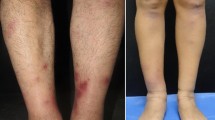Abstract
In ordinary urticaria, individual lesions disappear within 24 hours. However, we sometimes encounter patients whose eruptions last longer than 24 hours, but without evidence of vasculitis or a history of exposure to pressure. In these patients, histology reveals a perivascular infiltration, predominantly of eosinophils, depending on the timing of the biopsy. Unlike urticarial vasculitis, no immunoglobulins, complement deposition, or endothelial fibrinoid degeneration is observed. The peripheral eosinophil counts and serum complement levels appear within normal range. No protein urea or joint pain is observed, and the lesions can be controlled only by systemic glucocorticoids. We recognize such a urticarial reaction as a different clinical entity than usual urticaria, which is presumably mediated by latephase inflammatory reaction in immediate hypersensitivity.
Similar content being viewed by others
References and Recommended Reading
Zuberbier T, Greaves MW, Juhlin L, et al.: Definition, classification, and routine diagnosis of urticaria: a consensus report. J Investig Dermatol Symp Proc 2001, 6:123–127. (See note under reference 2.)
Zuberbier T, Greaves MW, Juhlin L, et al.: Management of urticaria: a consensus report. J Investig Dermatol Symp Proc 2001, 6:128–131. The above two articles are a result of the International Clinical Oriented ESDR Symposium on Urticaria, held in Berlin, Germany, in September, 2000. These articles introduce the latest concepts about urticaria, and will be helpful to practitioners in the management of patients, and researchers who attempt to investigate the numerous unclarified aspects of the disease.
Hide M, Francis DM, Grattan CE, et al.: Autoantibodies against the high-affinity IgE receptor as a cause of histamine release in chronic urticaria. N Engl J Med 1993, 328:1599–1604.
Miyachi Y, Kurosawa M: Mast cells in clinical dermatology. Australas J Dermatol 1998, 39:14–18.
Kanbe N, Kurosawa M, Nagata H, et al.: Production of fibrogenic cytokines by cord blood-derived cultured human mast cells. J Allergy Clin Immunol 2000, 106:S85-S90.
Kano Y, Orihara M, Shiohara T: Cellular and molecular dynamics in exercise-induced urticarial vasculitis lesions. Arch Dermatol 1998, 134:62–67.
Mehregan DR, Gibson LE: Pathophysiology of urticarial vasculitis. Arch Dermatol 1998, 134:88–89.
Sais G, Vidaller A: Pathogenesis of exercise-induced urticarial vasculitis lesions: can the changes be extrapolated to all leukocytoclastic vasculitis lesions? Arch Dermatol 1999, 135:87–89. This article, which complements those of references 4 and 5, provides a good opportunity to reconsider the mechanism of leukocyte migration through the endothelial cells.
Haas N, Hermes B, Henz BM: Adhesion molecules and cellular infiltrate: histology of urticaria. J Invest Dermatol Symp Proc 2001, 6:137–138.
Black AK: Unusual urticarias. J Dermatol 2001, 28:632–634.
Kobza-Black A: Delayed pressure urticaria. J Investig Dermatol Symp Proc 2001, 6:148–149.
Mekori YA, Dobozin BS, Schocket AL, et al.: Delayed pressure urticaria histologically resembles cutaneous late-phase reactions. Arch Dermatol 1988, 124:230–235.
McEvoy MT, Peterson EA, Kobza-Black A, et al.: Immunohistological comparison of granulated cell proteins in induced immediate urticarial dermographism and delayed pressure urticaria lesions. Br J Dermatol 1995, 133:853–860.
Czarnetzki BM, Meentken J, Kolde G, Brocker EB: Morphology of the cellular infiltrate in delayed pressure urticaria. J Am Acad Dermatol 1985, 12:253–259.
Kitao A, Nobuhara S, Kore-Eda S, et al.: Persistent urticariaurticarial reaction caused by late phase reaction? Eur J Dermatol 2001, 11:440–442.
This is our first report on late phase urticaria patients.
Sugita Y, Morita E, Kawamoto H, et al.: Correlation between deposition of immuno-components and infiltration pattern of polymorphonuclear leukocytes in the lesions of chronic urticaria. J Dermatol 2000, 27:157–162.
Doutre M: Physiopathology of urticaria. Eur J Dermatol 1999, 9:601–605.
Kline BS, Cohen MB, Rudolph JA: Histologic changes in allergic and non-allergic wheals. J Immunol 1932, 3:531–541.
Solley GO, Gleich GJ, Jordan RE, Schroeter AL: The late phase of the immediate wheal and flare skin reaction. J Clin Invest 1976, 58:408–420.
Author information
Authors and Affiliations
Rights and permissions
About this article
Cite this article
Kambe, N., Kitao, A., Nishigori, C. et al. Late-phase urticaria update. Curr Allergy Asthma Rep 2, 288–291 (2002). https://doi.org/10.1007/s11882-002-0052-8
Issue Date:
DOI: https://doi.org/10.1007/s11882-002-0052-8




